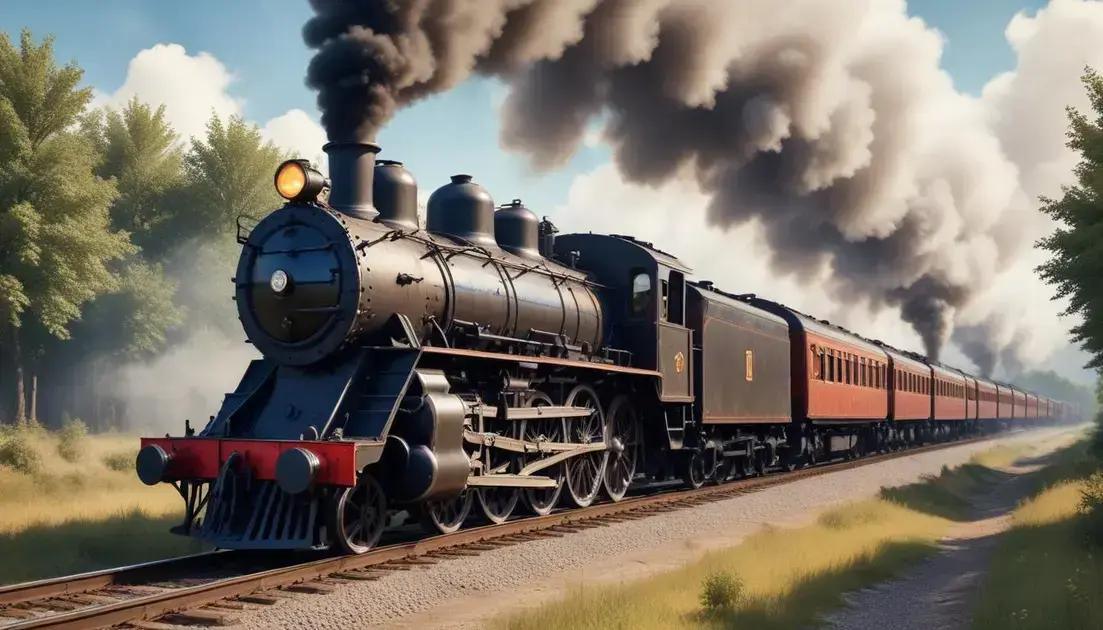
Steam Locomotive: Trains and the Transportation Revolution
The evolution of steam locomotives significantly transformed transport and economies by improving travel speed and safety. Railroads connected rural areas to urban centers, stimulating trade and migration, while technological innovations enhanced efficiency. The future of rail transport looks promising with advancements like high-speed trains and eco-friendly technologies, focusing on improving the travel experience and reducing environmental impact.
In the midst of the Railroads revolution, steam locomotives emerged as game changers. Imagine communities once isolated, suddenly connected, sparking economic growth and migration!
The Historical Significance of Steam Locomotives
Steam locomotives were a big deal back in the day. They changed how people traveled and moved goods. With a steam engine, trains could carry heavy loads quickly across long distances. This changed everything for businesses and communities.
Connecting Communities
Before railroads, many towns were cut off from the rest of the world. When steam locomotives arrived, they connected these places. Goods, ideas, and people could move freely. This meant more opportunities for everyone.
Boosting the Economy
Railroads helped businesses grow. They made it easier to transport products to markets. Farmers could send their crops to cities. Factories could get raw materials quickly. This led to cheaper goods and more jobs.
Stimulating Migration
As railroads expanded, people moved in search of new opportunities. Many families left their homes to find work in growing cities. This wave of migration changed the landscape of America.
Technological Innovations
The era of steam locomotives sparked many inventions. Engineers worked tirelessly to improve speed and efficiency. These innovations laid the groundwork for modern rail systems we use today.
Overall, steam locomotives played a key role in shaping the world we live in. Their historical significance is immense, making them a fascinating topic to explore.
Impact on Transportation
The steam locomotive had a huge impact on transportation. It changed how people and goods moved from place to place. Before trains, travel was slow and difficult. With steam engines, journeys became faster and more comfortable.
Speeding Up Travel
Trains could travel long distances quickly. Passengers no longer had to rely on horses or carriages. Instead, they could hop on a train and reach their destination in hours instead of days.
Connecting Regions
Railroads brought distant towns and cities closer together. They made it easy to connect rural areas to urban centers. This opened up new opportunities for trade and travel.
Transforming Cargo Transport
Freight transport also changed with steam locomotives. Trains could carry large amounts of goods effectively. This was a game changer for businesses, as products could move quickly to markets.
Reducing Costs
With improved transportation, costs went down. Moving goods by train was cheaper than by wagon or boat. Lower transportation costs helped lower prices for consumers.
The impact of steam locomotives on transportation can still be seen today. They paved the way for modern trains and transportation systems, making them essential for economic growth and mobility.
Economic Transformation
The introduction of steam locomotives led to major economic transformation. These trains made it easier to transport goods and people. As a result, local economies began to grow rapidly.
Stimulating Trade
With railroads, businesses could trade with distant markets. Farmers shipped crops to cities, while manufacturers sent products across the country. This increased trade created new jobs and opportunities.
Lowering Transportation Costs
Steam locomotives greatly reduced transportation costs. Moving goods by train was much cheaper than by wagon or riverboat. Lower costs meant that prices for consumers dropped as well.
Encouraging Urbanization
As economies grew, more people moved to cities for work. Railroads connected rural areas to urban centers. This migration changed the social and economic landscape of the nation.
Innovating Industries
With increased efficiency and cheaper transport, many industries bloomed. From agriculture to manufacturing, businesses reinvented how they operated. This innovation sparked a wave of economic growth that shaped modern America.
Steam locomotives didn’t just transform transportation; they transformed the entire economy. Their effects are still felt today as we rely on efficient systems to keep our economy moving.
Railroads and Migration Patterns
Railroads played a big role in shaping migration patterns in the United States. They made it much easier for people to move from one place to another. With trains, traveling long distances became faster and more comfortable.
Encouraging Westward Expansion
As railroads spread across the country, many people headed west. Families sought new opportunities and land. This migration helped grow cities and towns in the West.
Bridging Communities
Trains connected rural areas to cities. This meant that jobs and resources were more accessible. People living in small towns could find work and improve their lives in urban areas.
Impact on Immigrants
Railroads were also a lifeline for immigrants. Many arrived in the U.S. looking for a better life. Trains helped them reach their new homes quickly and safely.
Changing Demographics
As people moved, the demographics of regions changed. Immigration and migration began to diversify communities. This mix of backgrounds enriched cultures and economies.
Overall, railroads changed how and where people lived. The connections they made shaped America into a diverse and bustling nation.
Technological Innovations in Rail Systems
Technological innovations in rail systems changed the way trains operate. These advancements improved safety, speed, and efficiency. Early steam locomotives were just the beginning.
Advancements in Engine Design
As engineers learned more, they designed better engines. Improved steam engines increased power and reduced fuel consumption. This made trains faster and more reliable.
Track Improvements
Innovations in track design played a big role too. Better materials and construction methods made tracks safer. Curved tracks allowed for quicker travel between cities.
Signaling Systems
Modern railroads use advanced signaling systems. These help trains communicate with each other. Signals prevent collisions and improve scheduling. Innovations like automated systems make train travel smoother.
Passenger Comfort
Technological improvements also made travel more comfortable. Trains now have better seating and climate control. This enhances the passenger experience and encourages train travel.
Overall, these technological innovations shaped the rail industry. They laid the groundwork for the efficient rail systems we rely on today.
Future of Rail Transport
The future of rail transport looks bright and exciting. Technology continues to evolve, making trains faster and greener. Innovations are shaping how we think about traveling and transporting goods.
High-Speed Trains
High-speed trains are becoming more common. These trains will connect cities faster than ever. With speeds over 200 mph, they cut travel time significantly.
Eco-Friendly Technologies
Green technologies will play a major role in rail transport. Many companies are investing in electric and hybrid trains. These options reduce emissions and lower pollution.
Smart Rail Systems
The industry is also embracing smart technology. Using AI and data, trains can operate more efficiently. Smart systems help with scheduling and maintenance, preventing delays.
Passenger Experience Enhancements
The passenger experience will improve too. Future trains may offer features like Wi-Fi, comfortable seating, and better dining options. Travelers will enjoy a pleasant journey from start to finish.
Rail transport is on the verge of transformation. With advancements in technology, it will become faster, cleaner, and more efficient.
Conclusion
In conclusion, the evolution of steam locomotives and rail transport has significantly shaped our world. From connecting communities to boosting economies, trains have transformed how we live and work. With technological innovations, rail systems have become safer, faster, and more efficient.
As we look to the future, developments like high-speed trains and eco-friendly technologies promise even greater changes. These advancements will not only enhance our travel experience but also help protect our planet.
Investing in rail transport is essential for continued growth. As trains become more integrated into our daily lives, they will play a vital role in moving people and goods efficiently. Understanding and supporting these changes ensures a better future for rail travel and its impact on society.


